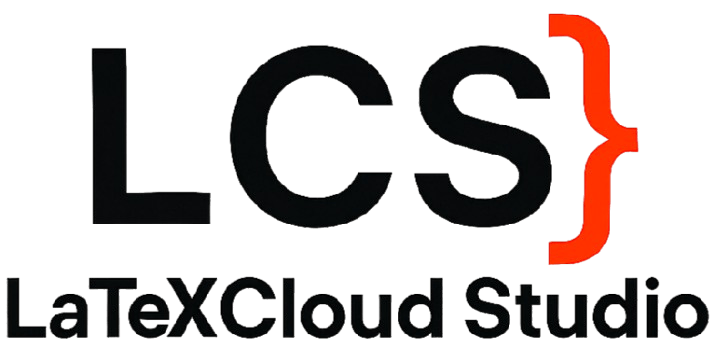Real-time Collaboration
LaTeX Cloud Studio transforms collaborative LaTeX writing with Google Docs-style real-time editing, while maintaining the power and precision of LaTeX. Work together seamlessly, whether you’re across the hall or across the globe.Instant Sync: Changes appear in real-time for all collaborators. No more emailing files or managing version conflicts.
Real-time Editing Features
Live Collaborative Editing
Experience true real-time collaboration:Live Cursors
See exactly where your collaborators are working with named, colored cursors
Instant Updates
Changes sync instantly - see edits as they happen, character by character
Conflict Resolution
Automatic handling of simultaneous edits with intelligent conflict resolution
Network Resilience
Robust handling of network interruptions with automatic reconnection
Visual Collaboration Indicators
Track team activity at a glance:Collaborative Awareness
Always know who’s working on what:- Active users panel shows who’s currently online
- Recent activity feed displays latest changes and authors
- Edit indicators highlight recent modifications with author attribution
- Focus indicators show which sections teammates are viewing
Permission Management
Access Control Levels
Fine-grained permissions for different collaboration needs:- Owner
- Editor
- Commenter
- Viewer
Full Control
- Edit document content
- Manage collaborator permissions
- Delete or archive project
- Export and publish
- Billing and subscription management
Team Management
Organize large collaborative projects:Invitation System
Multiple ways to add collaborators:- Email invitations with custom messages
- Shareable links with embedded permissions
- Organization integration for automatic team access
- Guest access for external reviewers without accounts
Comment and Review System
Threaded Comments (Planned)
Rich commenting system for feedback and discussion:Planned Comment Features
Rich Comments
Add formatted text, links, and LaTeX code in comments
Line-specific
Comments attach to specific lines or selections
Thread Management
Organize discussions with threaded replies and resolutions
Notifications
Get notified of new comments and replies via email or in-app
Suggestion Mode (Planned)
Non-destructive editing for reviewers:Review Workflows (Planned)
Structured review processes:- Draft Phase - Authors create initial content
- Internal Review - Team members add comments and suggestions
- External Review - Outside experts provide feedback
- Revision Phase - Incorporate feedback and track changes
- Final Review - Last check before submission
Version Control and History
Automatic Version Tracking
Every change is automatically saved and tracked:- Continuous snapshots created every few minutes
- Major versions created at significant milestones
- Author attribution for every change
- Timestamp tracking with timezone support
Version Comparison
Visual diff tools for understanding changes:Named Versions
Create meaningful checkpoints:Restore Capabilities
Flexible version management:- Point-in-time restore to any previous version
- Selective restore of specific sections or files
Coming Soon: Branch creation and merge capabilities are planned for a future release with Git integration.
File Management
Project Organization
Keep collaborative projects organized:Shared Assets
Centralized resource management:- Shared figure library accessible to all team members
- Common bibliography maintained collaboratively
- Template repository for consistent formatting
- Style guide documentation for team standards
File Synchronization
Automatic sync across all devices:- Real-time file updates when collaborators add/modify files
- Conflict resolution for simultaneous file operations
- Lock indicators when files are being actively edited
- Upload notifications when new files are added
Communication Tools
Activity Feed
Track all project activity:- Recent edits with author and timestamp
- File uploads and modifications
- Comment additions and resolutions
- Version creations and naming
- Permission changes and team updates
Notifications
Stay informed without being overwhelmed:Real-time Alerts
Instant notifications for comments directed at you
Daily Digest
Summary emails of project activity
Milestone Alerts
Notifications for version releases and deadlines
Custom Filters
Choose which activities trigger notifications
Advanced Collaboration Features
100% LaTeX Compatibility
Seamless integration with existing workflows:- Import from any LaTeX editor without formatting loss
- Export to standard LaTeX for external processing
- Full package support - no limitations on LaTeX features
- BibTeX/BibLaTeX compatibility with existing bibliographies
Cross-platform Editing
Work from any device:- Web browser access - no software installation required
- Mobile-friendly interface for reviewing on the go
- Tablet support for reading and annotation
Coming Soon: Offline editing with automatic sync is planned for a future release.
Integration Capabilities
Currently available:- Git Integration - Automatic commits, branch management, pull request workflows
- Reference Managers - Direct import from Zotero, Mendeley, EndNote
Best Practices for Team Collaboration
Team Workflow Patterns
For Academic Papers:- Principal investigator creates project and adds team
- Each author works on assigned sections
- Regular review cycles with comment-based feedback
- Version control for submission iterations
- Project manager sets up structure and permissions
- Subject matter experts contribute content
- Technical writers review and edit for consistency
- Stakeholders provide feedback through comments
- Team leader creates shared project
- Each member responsible for specific sections
- Peer review through comment system
- Instructor access for guidance and grading
Getting Started with Collaboration
- Create your project or open an existing document
- Click “Share” in the top toolbar
- Add collaborators by email or shareable link
- Set permissions appropriate for each team member
- Start collaborating - changes sync immediately
- Use comments for feedback and discussion
- Create versions at important milestones
Need help? Check our Collaboration Tutorial for step-by-step guidance and advanced tips.
